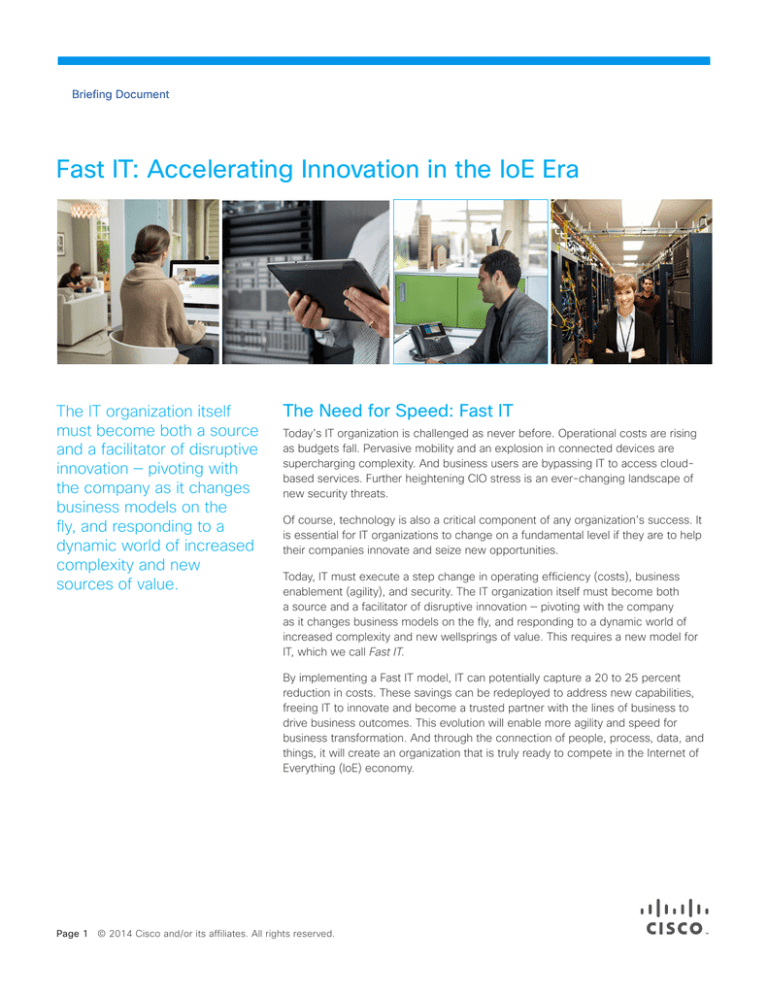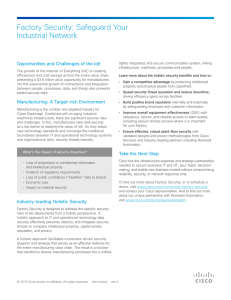
Briefing Document
Fast IT: Accelerating Innovation in the IoE Era
The IT organization itself
must become both a source
and a facilitator of disruptive
innovation — pivoting with
the company as it changes
business models on the
fly, and responding to a
dynamic world of increased
complexity and new
sources of value.
The Need for Speed: Fast IT
Today’s IT organization is challenged as never before. Operational costs are rising
as budgets fall. Pervasive mobility and an explosion in connected devices are
supercharging complexity. And business users are bypassing IT to access cloudbased services. Further heightening CIO stress is an ever-changing landscape of
new security threats.
Of course, technology is also a critical component of any organization’s success. It
is essential for IT organizations to change on a fundamental level if they are to help
their companies innovate and seize new opportunities.
Today, IT must execute a step change in operating efficiency (costs), business
enablement (agility), and security. The IT organization itself must become both
a source and a facilitator of disruptive innovation — pivoting with the company
as it changes business models on the fly, and responding to a dynamic world of
increased complexity and new wellsprings of value. This requires a new model for
IT, which we call Fast IT.
By implementing a Fast IT model, IT can potentially capture a 20 to 25 percent
reduction in costs. These savings can be redeployed to address new capabilities,
freeing IT to innovate and become a trusted partner with the lines of business to
drive business outcomes. This evolution will enable more agility and speed for
business transformation. And through the connection of people, process, data, and
things, it will create an organization that is truly ready to compete in the Internet of
Everything (IoE) economy.
Page 1 © 2014 Cisco and/or its affiliates. All rights reserved.
Briefing Document
The Big Question:
How Can IT Accelerate Innovation?
To understand the extent to which IT organizations are helping bring about the
transformation required to take advantage of IoE, and which factors are holding
them back, Cisco undertook a multipronged research effort. We surveyed more
than 1,400 senior IT leaders, conducted in-depth interviews with IT luminaries, and
leveraged our own work with customers who are implementing IoE solutions. The
study revealed important insights into the changes needed to succeed in an IoE
world.
Key Challenges for the CIO
• IoE Is Supercharging IT Complexity — and IT Challenges: While there has
always been a high level of complexity in IT, IoE is supercharging that complexity.
Cloud, Big Data, and other IoE drivers create opportunities for innovation, but
their added complexity can hamper it. Eighty percent of executives surveyed
see IoE as a “significant” or “very significant” challenge for their organizations.
Implication: The old way of doing things won’t work in the IoE era.
IT leaders understand the
need to take on the service
orchestrator role — but costly,
unwieldy, inadequately
secured infrastructure is
holding them back.
• Apps Are the Oxygen of the Business (but Can Smother IT): The proliferation,
criticality, and interdependence of applications are all dramatically increasing.
Application downloads will reach 138 billion worldwide in 2014 (Gartner, 2013).
Ensuring application health is an increasingly essential role for IT. One of the
greatest application challenges is provisioning enterprise applications at scale
— rated a 7.5 out of 10 (10 being most significant) by survey respondents.
According to Cisco’s Padmasree Warrior, “Infrastructure needs to serve up
functionality such as policy, quality of service, traffic prioritization, and so forth.
Then, it must optimize all the resources to deliver against what the application
needs.” Implication: Innovation and agility are stifled if IT is unable to deploy and
manage applications efficiently.
• Lines of Business Are Taking IT into Their Own Hands: Research revealed
that nearly half (46 percent) of total IT spending now occurs outside the
confines of the corporate IT organization. Shadow IT is coming out of the
shadows and cannot be ignored. Jaimie Capella of Corporate Executive Board
believes that having shared responsibility for technology is a good thing for the
business: “Technology is not IT’s problem alone, much in the same way that
talent is not solely HR’s responsibility.” Implication: IT needs to embrace the
shared responsibility model and reimagine the IT-LoB partnership.
• Service Orchestration Has Been CIOs’ “White Whale”: Ninety percent of IT
executives surveyed said they agreed that IT organizations should be brokers,
or “orchestrators,” of services, applications, experiences, and new capabilities.
They also conceded that this was the number-one area where they were falling
short. Implication: IT leaders understand the need to take on the service
orchestrator role — but costly, unwieldy, inadequately secured infrastructure is
holding them back.
Page 2 © 2014 Cisco and/or its affiliates. All rights reserved.
Briefing Document
Fast IT: The Way Forward
• IoE Demands a New Operating Model: Ninety percent of respondents
agreed that “agile” IT infrastructure models were the way of the future. Zeus
Kerravala of ZK Research shared his firm’s latest data, explaining that “IT shops
now devote upwards of 80 percent of the total IT spend to ‘keeping the lights
on,’” with a worsening trend line in recent years. This lockup of IT spend pushes
innovation to the margins of the IT portfolio, leaving little budget or human capital
to drive better business outcomes. Implication: Without addressing fundamental
complexity challenges, any effort to drive IT transformation will be a recipe for
failure.
Companies currently devote
less than 20 percent
of total IT spending to
transformation-oriented
initiatives — so the savings
from Fast IT amount
to a doubling of the IT
organization’s contribution
to the firm’s overall
“innovation capacity.”
• A Fabric of Clouds Provides the Platform for Change: Cloud is a key element
of the Fast IT story — the dominant model moving forward will be based on
hybrid-cloud infrastructures (a fabric of clouds). The key goal is to access the
optimum cloud model for any business challenge, as it arises. Respondents
said their ability to derive value from cloud and new applications is hampered
by the state of their enterprise networks — with two-thirds agreeing that they
are not realizing the value of cloud. Implication: The ability to shift workloads
throughout a hybrid cloud-based fabric of connections — while assuring
compliance and security — will underpin a new platform for service delivery
enhancements, increased productivity, and business agility.
• Intelligence “at the Edge” Enables the Real-Time Business: All those devices
and sensors connected via the mobile cloud will generate torrents of data.
Enterprises must leverage data — whether it is at rest in the data center or realtime data in motion at the network edge. Data in motion has a shorter shelf life,
and gives the business the power to deliver transformational insights by operating
in real time. Steve Lucas, president of SAP Platform Solutions, says: “Big Data
is perhaps the area in which IT can play the most central role in business
innovation.” Implication: Context-aware, real-time IT services will provide the
next battleground for customer mindshare and employee productivity.
• In the IoE Era, the Security Perimeter Is Ever Expanding: When we “connect
the unconnected” with IoE, new security threats inevitably materialize. Seventythree percent of respondents expect security threats to increase in severity
over the next two years. Implication: Fast IT must deliver security via a platformdriven approach in which all infrastructure domains, devices, applications, and
services are integrated to enable greater intelligence, automation, and efficacy of
threat detection.
• IT Can’t Afford to Be Seen as the “Department of No”: IoE is not just about
data and things — it’s also about people and process. Several of our industry
luminaries identified culture and leadership as the most critical components
of the Fast IT transformation, saying that IT’s transformation will be a journey.
According to Zeus Kerravala of ZK Research, “Culturally, IT organizations often
get stuck in these models of ‘If it ain’t broke, don’t fix it.’ Frankly, those are very
dangerous words. Technology doesn’t stand still, nor should IT departments.”
Implication: CIOs must lead by example, demonstrating a “service partner”
mentality so that grassroots innovations can flourish.
Page 3
© 2014 Cisco and/or its affiliates. All rights reserved.
Briefing Document
• Capturing the “IoE Dividend”: IT and the vendor community have already
done a heroic job of lowering total cost of ownership (TCO), but another very
significant wave of TCO improvements is at hand. Cisco estimates a 20 to 25
percent improvement in IT costs as a result of Fast IT. This IoE dividend can
be redeployed to address new business capabilities. Implication: Companies
currently devote less than 20 percent of total IT spending to transformationoriented initiatives — so the savings from Fast IT amount to a doubling of the IT
organization’s contribution to the firm’s overall “innovation capacity.”
What Are Some Examples of How Cisco Is Helping
Customers Achieve Fast IT Now?
• In the data center: Cisco® UCS® is a perfect example of the kind of integrated
infrastructure that is eliminating complexity and enabling agility. Its integration
of network, compute, and storage provides the foundation for pervasive
management automation and orchestration for physical or virtual systems,
significantly reducing the management burden on IT.
This research confirms that
IT cannot deliver innovation
at the pace IoE requires
with the IT model they have
today. But business is not
waiting for IT. Amazon is not
cheaper or better — it’s just
faster.
• Cisco’s Intercloud strategy is providing the seamless fabric of clouds CIOs
need to deliver a platform for change.
• Cisco Application Centric Infrastructure’s programmability delivers the
superior application performance and agility IT departments need to support
the massive increase in the number of applications, while also providing the
intelligent network foundation to enable the cloud, mobile solutions, and platformbased security.
• Customers can accelerate their ability to harness the value of analytics
by leveraging Cisco’s UCS Common Platform Architecture for Big Data — now
with UCS systems at the core and at the edge; powerful data virtualization
software (a product of Cisco’s Composite acquisition); and Cisco’s emerging
analytics solutions for retail, service provider, collaboration, contact center, and
the network.
• Cisco offers a wide range of Connected Mobile Experiences solutions,
helping employees be more productive than ever, and providing end customers
with breakthrough experiences.
• And, Cisco’s leading, platform-based approach to security delivers security
designed for the IoE era, with comprehensive protection before, during, and after
an attack.
To view the full “Fast IT Study Findings” report, please visit:
http://cs.co/9003WW5X


